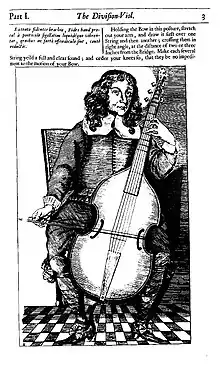Division viol
The division viol is an English type of bass viol, which was originally popular in the mid-17th century, but is currently experiencing a renaissance of its own due to the movement for historically informed performance. John Playford mentions the division viol in his A Brief Introduction of 1667, describing it as smaller than a consort bass viol, but larger than a lyra viol.[1]
 | |
| Classification | |
|---|---|
| Related instruments | |

As suggested by its name, (divisions were a type of variations), the division viol is intended for highly ornamented music, and for improvisations. The division viol also had a very large range with the tuning D–G–c–e–a–d', resulting in the ability of skilled players to play divisions on any part in a polyphonic vocal piece.[1]
The division viol may be historically connected with the viola bastarda, and came into being in the mid-17th century in England.[1] Music for the division viol was mainly linear, although there were occasionally lyra-like passages, and music for it was written on a staff, rather than in tablature like the lyra viol's music.
Christopher Simpson, a prominent viol player, wrote a treatise on how to play the division viol, aptly titled The Division-viol, or The Art of Playing ex tempore to a Ground (1665), and also The Division-Violist (1659). Both of these are frequently used as references by those interested in historically informed performance on the viol.
Although the division viol is a specialized instrument for playing divisions, divisions of the same period that this instrument flourished were almost as likely to be played on a consort bass or a lyra viol, and instruments constructed as division viols were certainly used in consorts when called upon.[2]
References
- Frank Traficante. "Division viol", Grove Music Online, ed. L. Macy (accessed July 29, 2006), grovemusic.com Archived 2008-05-16 at the Wayback Machine (subscription access).
- Frank Traficante. "Division", Grove Music Online, ed. L. Macy (accessed July 29, 2006), grovemusic.com Archived 2008-05-16 at the Wayback Machine (subscription access).
- "Division viol"
- "Division"
External links
- The Division Viol (Simpson)
- A Brief Introduction (Playford)